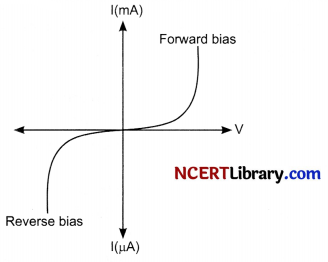Practicing the CBSE Sample Papers for Class 12 Physics with Solutions Set 1 allows you to get rid of exam fear and be confident to appear for the exam.
CBSE Sample Papers for Class 12 Physics Set 1 with Solutions
Time : 3 Hours
Maximum Marks: 70
General Instructions :
- There are 35 questions in all. All questions are compulsory.
- This question paper has five sections: Section A, Section B, Section C, Section D and Section E. All the sections are compulsory.
- Section A contains eighteen MCQs of 1 mark each, Section B contains seven questions of two marks each, Section C contains five questions of three marks each, Section D contains three long questions of five marks each and Section E contains two case study based questions of 4 marks each.
- There is no overall choice. However, an internal choice has been provided in Section B, C, D and E. You have to attempt only one of the choices in such questions,
- Use of calculators is not allowed.
Section – A
The following questions are multiple-choice questions with one correct answer. Each question carries 1 mark. There is no internal choice in this section.
Question 1.
According to Coulomb’s law, which is the correct relation for the following figure? [1]
![]()
Answer:
(b) q1q2 > 0
Explanation: According to the Coulomb’s law, the force of attraction or repulsion between two charged bodies is directly proportional to the product of their charges and inversely proportional to the square of the distance between them. It acts along the line joining the two charges considered to be point charges.
![]()
i.e., F = \(\frac{q_1 q_2}{4 \pi \varepsilon_0 r^2}\)
Coulomb’s law holds for stationary charges only, which are point sized. This law obeys Newton’s third law of motion.
F12 = – FF21
Here F12 is the force exerted by q1 on q2 and F21 is the force exerted by q2 on q1
There is a force of attraction and the charge must be unlike charge.
For attractive force, q1 q2 < 0
q1= + ve
q2 = – ve
q1q2 < 0
The correct option is (b).
Question 2.
The electric potential on the axis of an electric dipole at a distance V from it’s centre is V. Then the potential at a point at the same distance on its equatorial line will be: [1]
(a) 2 V
(b) – V
(c) \(\frac { V }{ 2 }\)
(d) Zero
Answer:
(d) Zero
Explanation: The electric potential at a point due to an electric dipole is given by:
V = \(\frac{k \mathrm{P} \cos \theta}{r^2}\)
For an equatorial plane,
θ = \(\frac { π }{ 2 }\)
and we know that cos 90° = 0.
So, the potential at a point at the same distance on its equatorial line is given by,
V = \(\frac{k \mathrm{P} \cos 90^{\circ}}{r^2}\)
V = 0
Hence option (d) is correct.
Question 3.
The temperature (T) dependence of resistivity of material A and material B is represented by Fig. (i) and Fig. (ii) respectively. Identify material A and material B. [1]
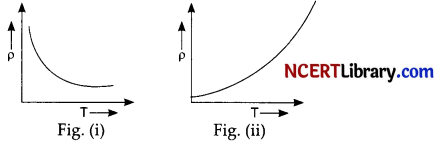
(a) material A is copper and material B is germanium
(b) material A is germanium and material B is copper
(c) material A is nichrome and material B is germanium
(d) material A is copper and material B is nichrome Answer: (b) material A is germanium and material B is copper
Explanation:
For semiconductors, there are very few free electrons. The conductor’s resistance decreases as a result of an increase in the number of free electrons that can act as carriers as a result of rising temperature [Fig. (i)]
For a conductor, when temperature rises, more free electrons become available. As a result, more of them begin to opposes one another’s motion, incresing the conductor’s resistance[Fig,(ii)]
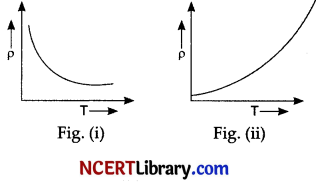
We know germanium is a semiconductor while copper is a conductor.
So, fig. (i) is a semiconductor while fig. (ii) is a conductor.
Hence, option (b) is correct.
Question 4.
Two concentric and coplanar circular loops P and Q have their radii in the ratio 2 : 3. Loop Q carries a current 9 A in the anti-clockwise direction. For the magnetic field to be zero at the common centre, loop P must carry: [1]
(a) 3A in clockwise direction
(b) 9A in clockwise direction
(c) 6 A in anti-clockwise direction
(d) 6 A in the clockwise direction
Answer:
(d) 6 A in the clockwise direction
Explanation: Given: Radius (R1) = 2x
Radius (R2) = 3x
Current (I2) = 9 A (anticlockwise)
To find: I1
We know that the magnetic field at the common centre due to the loop is zero.
So we can say that magnetic field magnitude will be equal but direction is opposite.
Therefore, B1 = B2
B = \(\frac{\mu_0 I}{2 R}\)
By using above relation,
\(\frac{\mu_0 I_1}{2 R_1}=\frac{\mu_0 I_2}{2 R_2}\)
\(\mathrm{I}_1=\mathrm{I}_2 \times \frac{\mathrm{R}_1}{\mathrm{R}_2}\)
I1 = 9 x \(\frac { 2 }{ 3 }\)
I1 = 6 A
But in opposite direction i.e., clockwise.
Hence,option (d) is correct.
![]()
Question 5.
A long straight wire of circular cross-section of radius a carries a steady current I. The current is uniformly distributed across its cross-section. The ratio of the magnitudes of magnetic field at a point distant a/2 above the surface of wire to that at a point distant a/2 below its surface is: [1]
(a) 4:1
(b) 1:1
(c) 4:3
(d) 3:4
Answer:
(c) 4:3
Explanation: We know that magnetic field B in inside points = \(\frac{\mu_0 I r}{2 \pi \mathrm{R}^2}\)
(where R is the radius and r = distance of the inside point from the axis and i = total current)
Distance from the axis at \(\frac { a }{ 2 }\) inside = (a – \(\frac { a }{ 2 }\)) = \(\frac { a }{ 2 }\)
So magnetic field at \(\frac { a }{ 2 }\) inside = \(\frac{\mu_0 \times i \times a}{2 \times\left(2 \pi a^2\right)}\)
= \(\frac{\mu_0 i}{4 \pi a}\)
Distance from the axis at \(\frac { a }{ 2 }\) outside = \(\frac { a }{ 2 }\) + \(\frac { a }{ 2 }\)
We know that magnetic field B in outside points = \(\frac{\mu_0 i}{2 \pi r}\)
(r = distance of the outside point from the axis and i = total current)
So magnetic field at \(\frac { a }{ 2 }\) outside = \(\frac{\mu_0 \times i}{(3 a / 2) \times 2 \pi}\)
= \(\frac{\mu_0 i}{3 \pi a}\)
\(\frac{\text { Magnetic field at outside }}{\text { Magnetic field at inside }}=\left(\frac{\mu_0 \mathrm{I} \times 4 \pi a}{\mu_0 \mathrm{I} \times 3 \pi a}\right)\)
Hence option (c) is correct.
Question 6.
If the magnetizing field on a ferromagnetic material is increased, its permeability: [1]
(a) decreases
(b) increases
(c) remains unchanged
(d) first decreases and then increases
Answer:
(a) decreases
Explanation: The magnetic permeability of a substance is defined as,
μ = B/H
where B is the established magnetic field inside the material and H is the applied external magnetic field.
When the external applied magnetic field H is increased, the established magnetic field for a ferromagnetic material remains the same.
Thus, the magnetic permeability decreases.
Hence option (a) is correct.
Question 7.
An iron cored coil is connected in series with an electric bulb with an AC source as shown in figure. When iron piece is taken out of the coil, the brightness of the bulb will: [1]
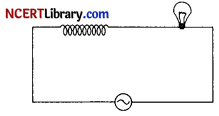
(a) decrease
(b) increase
(c) remain unaffected
(d) fluctuate
Answer:
(b) increase
Explanation:

As the iron rod is removed from the coil, the coil’s self-inductance falls, the circuit’s impedance drops, and the current rises as a result. Therefore, the electricity used by the bulb grows, as does the brightness of the bulb.
Hence option (b) is correct.
Question 8.
Which of the following statement is NOT true about the properties of electromagnetic waves? [1]
(a) These waves do not require any material medium for their propagation.
(b) Both electric and magnetic field vectors attain the maxima and minima at the same time.
(c) The energy in electromagnetic wave is divided equally between electric and magnetic fields.
(d) Both electric and magnetic field vectors are parallel to each other.
Answer:
(d) Both electric and magnetic field vectors are parallel to each other.
Explanation: In electromagnetic waves,
- The electric field and magnetic field vary continuously with time and have maxima and minima at the same place and at the same time.
- Both electric and magnetic fields have the same energy.
- Both electric and magnetic fields are perpendicular to each other and perpendicular to direction of propagation.
- These waves don’t require any material medium to propagate, they can propagate in vacuum as well.
Hence option (d) is correct.
Question 9.
A rectangular, a square, a circular and an elliptical loop, all in the (x-y) plane, are moving out of a uniform magnetic field with a constant velocity \(\vec{v}=v \hat{i}\). The magnetic field is directed along the negative z-axis direction. The induced emf, during the passage of these loops, out of the field region, will not remain constant for: [1]
(a) any of the four loops
(b) the circular and elliptical loops
(c) the rectangular, circular and elliptical loops
(d) only the elliptical loops
Answer:
(b) the circular and elliptical loops
Explanation: When the loops are being drawn out of the field, the rate at which the number of field lines cutting through the loop decreases will be a constant for square and rectangle loops, but not for circular or elliptical shapes.
Area coming out per second from the magnetic field is not constant for elliptical and circular loops, so induced emf, during the passage of these loops, out of the field region will not remain constant for the circular and the elliptical loops.
Hence option (b) is correct.
![]()
Question 10.
In a Young’s double slit experiment, the path difference at a certain point on the screen between two interfering waves is \(\frac { 1 }{ 8 }\) th of the wavelength. The ratio of intensity at this point to that at the centre of a bright fringe is close to: [1]
(a) 0.80
(b) 0.74
(c) 0.94
(d) 0.85
Answer:
(d) 0.85
Explanation: Given path difference, ∆x = \(\frac { λ }{ 2 }\)
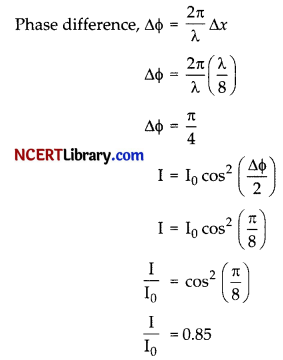
In Young’s double slit experiment, the path difference at a certain point on the screen between two interfering waves is \(\frac { 1 }{ 8 }\) th of the wavelength. The ratio of intensity at this point to that at the centre of a bright fringe is close to 0.85.
Hence option (d) is correct.
Question 11.
The work function for a metal surface is 4.14 eV. The threshold wavelength for this metal surface is: [1]
(a) 4125 Å
(b) 2062.5 Å
(c) 3000 Å
(d) 6000 Å
Answer:
(c) 3000 Å
Explanation: Given: Φ = 4.14 eV = 4.14 x 1.6 x 10-19 J
Since the work function for a metal surface is Φ = hv0 = hc/ λ0
Where λ0 is the threshold wavelength or cut-off wavelength for a metal surface.
λ0 = \(\frac{h c}{\phi}\)
λ0 = \(\frac{6.6 \times 10^{-34} \times 3 \times 10^8}{4.14 \times 1.6 \times 10^{-19}}\)
λ0 = 3000 Å
Hence option (c) is correct.
Question 12.
The radius of the innermost electron orbit of a hydrogen atom is 5.3 x 10-11 m. The radius of the n= 3 orbit is: [1]
(a) 1.01 x 10-10m
(b) 1.59 x 10-10m
(c) 2.12 x 10-10m
(d) 4.77 x 10-10m
Answer:
(d) 4.77 x 10-10m
Explanation: The radius of the innermost orbit of a hydrogen atom, r1 = 5.3 x 10-11 m.
The radius of the orbit is proportional to the square of n.
Let r2 be the radius of the orbit at n = 3.
r3 = r1 x 3²
= 5.3 x 10-11 x 9
= 4.77 x 10-10 m
Hence, the radii of an electron for n = 3 orbits is 4.77 x 10-10 m.
Hence option (d) is correct.
Question 13.
Which of the following statements about nuclear forces is not true? [1]
(a) The nuclear force between two nucleons falls rapidly to zero as their distance is more than a few femtometres.
(b) The nuclear force is much weaker than the Coulomb force.
(c) The force is attractive for distances larger than 0.8 fm and repulsive if they are separated by distances less than 0.8 fm.
(d) The nuclear force between neutron-neutron, proton-neutron and proton-proton is approximately the same.
Answer:
(b) The nuclear force is much weaker than the Coulomb force.
Explanation: The option (b) is incorrect because Coulomb’s force is much weaker than nuclear force. This is because the nuclear force needs to over power the Coulomb repulsive force between the like-charged protons inside the nucleus.
Question 14.
If the reading of the volumeter V1 is 40 V, then the reading of voltmeter V2 is: [1]
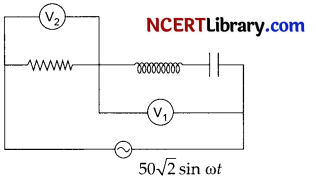
(a) 30 V
(b) 58 V
(c) 29 V
(d) 15 V
Answer:
(a) 30 V
Explanation:
Given:
Vrms = 50\(\sqrt{2}\)2sin ωt
V1 = 40 volt
A.C. voltmeters read r.m.s. value of voltage.
R.M.S. value of voltage applied is \(\frac{\mathrm{V}_{\mathrm{rms}}}{\sqrt{2}}\)
\(\mathrm{V}_{\mathrm{rms}}=\frac{50 \sqrt{2}}{\sqrt{2}}\)
Vrms = 50 V
V2 = \(\sqrt{\mathrm{V}_{\mathrm{rms}}{ }^2-\mathrm{V}_1^2}\)
V2 = \(\sqrt{50^2-40^2}\)
V2 = 30 V
Hence option (a) is correct.
Question 15.
The electric potential V as a function of distance X is shown in the figure. [1]
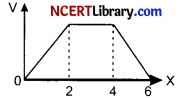
The graph of the magnitude of electric field intensity E as a function of X is:
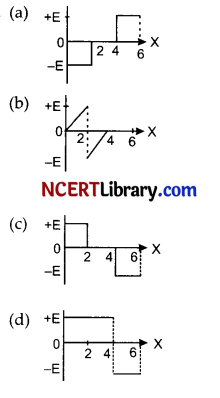
Answer:
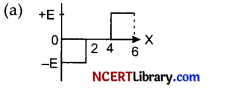
(Direction: Question 16 to 18) Two statements are given-one labelled Assertion (A) and the other labelled Reason (R). Select the correct answer to these questions from the codes (a), (b), (c) and (d) as given below.
(a) Both A and R are true and R is the correct explanation of A.
(b) Both A and R are true and R is not the correct explanation of A.
(c) A is true but R is false.
(d) A is false and R is false.
Question 16.
Assertion (A): The electrical conductivity of a semiconductor increases on doping. [1]
Reason (R): Doping always increases the number of electrons in the semiconductor.
Answer:
(c) A is true but R is false.
Explanation: This is true that electrical conductivity of a semiconductor increases on doping. In semiconductors, doping can be done with either electron rich or electron deficient impurities. Addition of such impurities cause the electronic defects in a crystal structure, which enhances the electrical conductivity. So, reason is wrong as doping always does not increase, the number of electrons in the semiconductor.
Hence, option (c) is correct.
![]()
Question 17.
Assertion (A): In an interference pattern observed in Young’s double slit experiment, if the separation (d) between coherent sources as well as the distance (D) of the screen from the coherent sources both are reduced to l/3rd, then new fringe width remains the same. [1]
Reason (R): Fringe width is proportional to (d/D).
Answer:
(c) A is true but R is false.
Explanation: We know that fringe width is proportional to \(\frac { D }{ d }\). In an interference pattern observed in Young’s double slit experiment, if the separation (d) between coherent sources as well as the distance (D) of the screen from the coherent sources both are reduced to \(\frac { 1 }{ 3 }\) rd, then new fringe width remains the same. This is true.
Fringe width = \(\frac{\frac{1}{3} \mathrm{D}}{\frac{1}{3} d}\) Fringe width = Remains same.
Hence option (c) is correct.
Question 18.
Assertion (A): The photoelectrons produced by a monochromatic light beam incident on a metal surface have a spread in their kinetic energies. [1]
Reason (R): The energy of electrons emitted from inside the metal surface, is lost in collision with the other atoms in the metal.
Answer:
(a) Both A and R are true and R is the correct explanation of A.
Explanation:
Different photoelectrons emit electrons at various speeds. Actually, not all electrons occupy the same energy level; instead, they do so in a continuous range of levels. As a result, the energy of the electrons that are knocked off at different levels vary.
The energy of electrons emitted from inside the metal surface is lost in collision with the other atoms in the metal.
Hence, option (a) is correct.
Section – B
Question 19.
Electromagnetic waves with wavelength: [2]
(i) λ1 is suitable for radar systems used in aircraft navigation.
(ii) λ2 is used to kill germs in water purifiers.
(iii) λ3 is used to improve visibility in runways during fog and mist conditions.
Identify and name the part of the electromagnetic spectrum to which these radiations belong. Also arrange these wavelengths in ascending order of their magnitude.
Answer:
(i) λ1 → Microwaves are considered suitable for radar systems used in aircraft navigation because they have a short wavelength range (10-3 m to 0.3 m), which makes them suitable for long range communication.
(ii) λ2 → UV rays, in water purifier ultraviolet rays are used to kill germs.
(iii) λ3 → Infrared rays, Infrared is used to improve visibility on runways during fog and mist conditions. So, it is the wavelength of infrared waves.
Ascending order of wavelength in ascending order:
Wavelength of UV rays < Wavelength of Infrared < wavelength of microwave i.e., λ2 < λ3 < λ1.
Question 20.
A uniform magnetic field gets modified as shown in figure when two specimens A and B are placed in it. [2]

(i) Identify the specimen A and B.
(ii) How is the magnetic susceptibility of specimen A different from that of specimen B?
Answer:
(i) A is diamagnetic and B is ferromagnetic.
(ii) Diamagnetic materials have permeabilities less than 1 (one) and have negative susceptibility. Their atoms and molecules do not have permanent dipole moment. The field lines get expelled in them. Ferromagnetic materials have permeability more than one and susceptibility positive. Their atoms and molecules have permanent dipole moment. So the field lines get concentrated in them.
Question 21.
What is the nuclear radius of 125Fe ,if that of 27Al is 3.6 fermi? [2]
OR
The short wavelength limit for the Lyman series of the hydrogen spectrum is 913.4 A. Calculate the short wavelength limit for the Balmer series of the hydrogen spectrum.
Answer:
For Aluminium (Al), Mass number = 27
RAl = 3.6 fermi
For Iron (Fe), Mass number = 125
RFe = ?
From the relation R = R0A1/3, where R0 is a constant and A is the mass number of a nucleus
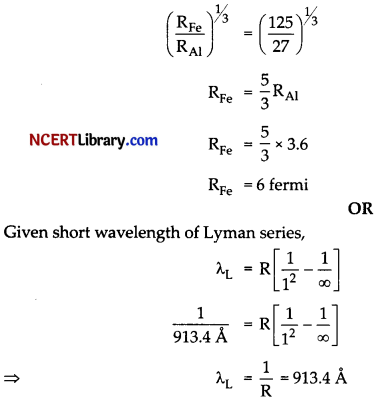
For the short wavelength of the Balmer series.
n1 = 2, n2 = ∞
\(\frac{1}{\lambda_B}=R\left[\frac{1}{2^2}-\frac{1}{\infty}\right]\)
λB = \(\frac { 4 }{ R }\) = 4 x 913.4 Å
= 3653.6 Å
Question 22.
A biconvex lens made of a transparent material of refractive index 1.25 is immersed in water of refractive index 1.33. Will the lens behave as a converging or a diverging lens? Justify your answer. [2]
Answer:
Generally, a biconvex lens acts as a converging lens in air because the refractive index of air is less than that of the material of the lens. The refractive index of water (1.33) is more than the refractive index of the material of the lens (1.25). So, on immersing in water it will behave as a diverging lens.
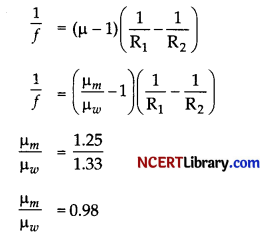
Where f is the focal length of the lens, µm is the refractive index of material of lens and µw is the refractive index of water.
The value of (µ – 1) is negative and focal length ‘f’ will be negative. So, it will behave like a diverging lens.
Question 23.
The figure shows a piece of pure semiconductor S in series with a variable resistor R and a source of constant voltage V. Should the value of R be increased or decreased to keep the reading of the ammeter constant, when semiconductor S is heated? Justify your answer: [2]
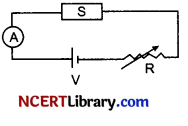
OR
The graph of potential barrier versus width of depletion region for an unbiased diode is shown in graph A. In comparison to A, graphs B and C are obtained after biasing the diode in different ways. Identify the type of biasing in B and C and justify your answer.

Answer:
As the semiconductors at room temperature act as insulators so they offer a very high resistance value. But with the increase in temperature, they start conducting by decreasing the energy-gap and hence they offer less resistivity. So, the resistivity of semiconductors decreases with the increase in temperature and as a result resistance also decreases. So to maintain the constant reading on the ammeter, we should increase the value of variable resistance R to compensate with the decreased value of resistance for the semiconductor.
Hence, to keep the reading of ammeter constant value of R should be increased as with the increase in temperature of a semiconductor, its resistance decreases and current tends to increase.
OR
B-reverse biased
In case of reverse biased diodes, the potential barrier becomes higher as the battery further raises the potential of the n-side. The effective barrier height under reverse biased is (V0 + V).
C-forward biased
Due to forward bias connection, the potential of the p side is raised and hence the height of the potential barrier decreases therefore, the effective barrier height is reduced to (V0 – V).
Question 24.
A narrow slit is illuminated by a parallel beam of monochromatic light of wavelength X equal to 6000 A and the angular width of the central maximum in the resulting diffraction pattern is measured. When the slit is next illuminated by light of wavelength X’, the angular width decreases by 30%. Calculate the value of the wavelength X’. [2]
Answer:
Given: λ = 6000 Å
We know,
Angular width 2θ = \(\frac { 2λ }{ d }\)
In case of new λ (assumed λ’ here), angular width decreases by 30%
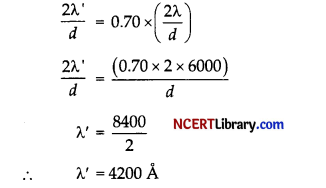
Question 25.
Two large, thin metal plates are parallel and close to each other. On their inner faces, the plates have surface charge densities of opposite signs and of magnitude 17.7 x 10-22 C/m2. What is electric field intensity E: [2]
(a) in the outer region of the first plate, and
(b) between the plates?
Answer:
The situation is represented in the following figure. A and B are two parallel plates close to each other.

Outer region of plate A is labelled as I, outer region of plate B is labelled as III, and the region between
the plates, A and B, is labelled as II
Surface charge density of plate A, σ = 17.7 x 10-22 C/m2.
Surface charge density of plate B, σ = -17.7 x 10-22 C/m2.
(a) In the regions I and III, electric field E is zero. This is because charge is not enclosed by the respective plates.
(b) Electric field E in region II is given by the relation, E = \(\frac{\sigma}{\varepsilon_0}\)
Where,
ε0 = Permittivity of free space = 8.85 x 10-12 N-1 C2 m-2
∴ ε = \(\frac{17.7 \times 10^{-22}}{8.85 \times 10^{-12}}\)
E = 2 × 10-10 N/C
Therefore, the electric field between the plates is 2 × 10-10 N/C
Section – C
Question 26.
Two long straight parallel conductors carrying currents I1 and 2 are separated by a distance d. If the currents are flowing in the same direction, show how the magnetic field produced by one exerts an attractive force on the other. Obtain the expression for this force and hence define 1 ampere. [3]
Answer:
Consider a small length L of the long straight conductor.
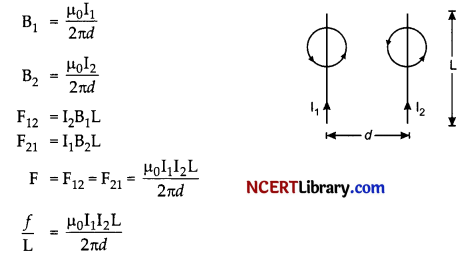
Ampere is that value of steady-state current, which when maintained in each of the very two long, straight, parallel conductors of negligible cross-section and placed lm apart in a vacuum produces 2 x 10-7 N/m force on each conductor.
Question 27.
The magnetic field through a circular loop of wire, 12 cm in radius and 8.5 Ω resistance, changes with time as shown in the figure. The magnetic field is perpendicular to the plane of the loop. Calculate the current induced in the loop and plot a graph showing induced current as a function of time. [3]
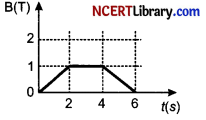
Answer:
Area of the circular loop = πr²
= 3.14 × (0.12)² m²
= 4.5 × 10-2m²
E = – \(\frac{d \phi}{d t}\)
= \(\frac { -d }{ dt }\)(BA)
= -A \(\frac { dB }{ dt }\)
E = – A\(\left(\frac{\mathrm{B}_2-\mathrm{B}_1}{t_2-t_1}\right)\)
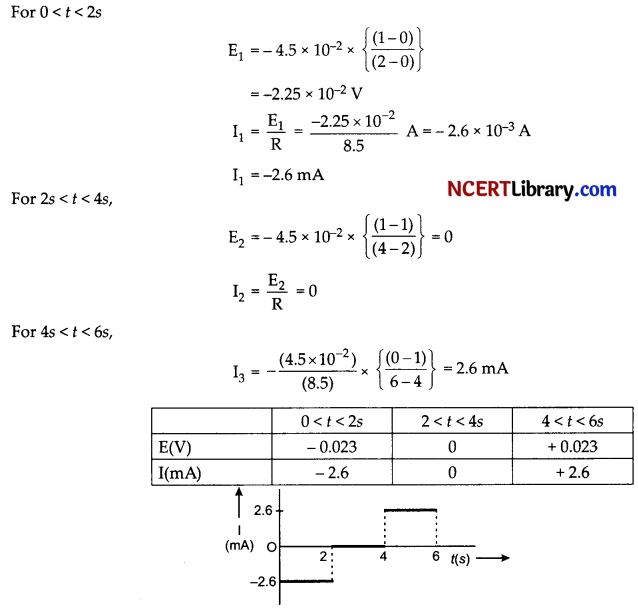
Question 28.
An a.c. source generating a voltage ε = ε0 sin ωt is connected to a capacitor of capacitance C. Find the expression for the current I flowing through it. Plot a graph of e and I versus at to show that the current is ahead of the voltage by \(\frac { π }{ 2 }\). [3]
OR
An a.c. voltage V = V0 sin at is applied across a pure inductor of inductance L. Find an expression for the current i, flowing in the circuit and show mathematically that the current flowing through it lags behind the applied voltage by a phase angle of \(\frac { π }{ 2 }\). Also draw graphs of V and i versus at for the circuit.
Answer:
Figure shows an AC source, generating a voltage e = e0 sin ωt. connected to a capacitor of capacitance C. The plates of the capacitor get charged due to the applied voltage. As the alternating voltage is reversed in each half cycle,
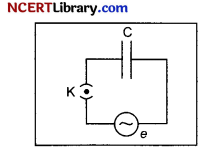
the capacitor is alternatively charged and discharged. If q is the charge on the capacitor, the corresponding potential difference across the plates of the capacitor is V = \(\frac { q }{ C }\)
∴ q = CV.
q and V are functions of time, with V = e = e0 sin ωt. The instantaneous current in the circuit is i = \(\frac { dq }{ dt }\) = \(\frac { d }{ dt }\) (CV) = C \(\frac { dV }{ dt }\)
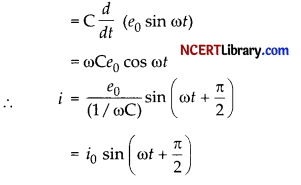
Where i0 = \(\frac{e_0}{(1 / \omega \mathrm{C})}\) is the peak value of the current.
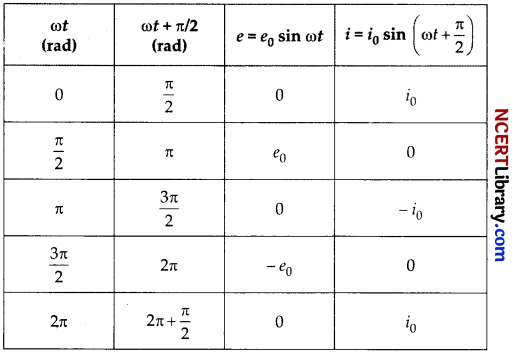
Table gives the values of e and i for different values of cot and Fig. shows graphs of e and i versus ωt. i leads e by a phase angle of π/2 rad.
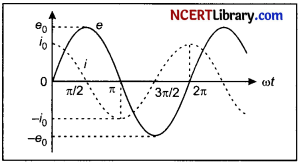
Graphs of e and i values wt for a purely capacitive AC circuit
OR
AC circuit containing pure inductance: Consider a coil of self-inductance L and negligible ohmic resistance. An alternating potential difference is applied across its ends. The magnitude and direction of AC changes periodically, due to which there is a continual change in magnetic flux linked with the coil. Therefore according to Faraday’s law, an induced emf is produced in the coil, which opposes the applied voltage. As a result the current in the circuit is reduced. That is inductance acts like a resistance in ac circuit. The instantaneous value of alternating voltage applied
V = V0 sin ωt.
If i is the instantaneous current in the circuit and \(\frac { di }{ dt }\) the rate of change of current in the circuit at that instant, then instantaneous induced emf
ε = -L \(\frac { di }{ dt }\)
According to Kirchhoff’s loop rule
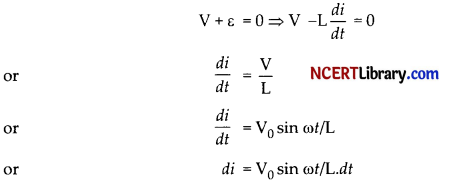
Integrating with respect to time ‘t’:

This is required expression for current
or i = i0 sin e \(\left(\omega t-\frac{\pi}{2}\right)\)
Where i0 is the peak value of alternating current.
Also comparing (i) and (iii), we note that current lags behind the applied voltage by an angle 2π.
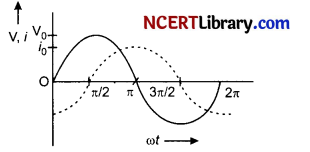
Question 29.
Radiation of frequency 1015 Hz is incident on three photosensitive surfaces A, B and C. Following observations are recorded: [3]
Surface A: no photoemission occurs
Surface B: photoemission occurs but the photoelectrons have zero kinetic energy.
Surface C: photo emission occurs and photoelectrons have some kinetic energy.
Using Einstein’s photo-electric equation, explain the three observations.
OR
The graph shows the variation of photocurrent for a photosensitive metal:
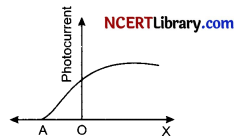
(a) What does X and A on the horizontal axis represent?
(b) Draw this graph for three different values of frequencies of incident radiation v1 v2 and v3 (v3 > v2 > v1) for the same intensity.
(c) Draw this graph for three different values of intensities of incident radiation I1 I2 and I3 (I3 > I2 > I1) having the same frequency.
Answer:
From the observations made (parts A and B) on the basis of Einstein’s photoelectric equation, we can
draw following conclusions:
1. For surface A, the threshold frequency is more than 1015 Hz, hence no photoemission is possible.
2. For surface B the threshold frequency is equal to the frequency of given radiation. Thus, photo emission takes place but the kinetic energy of photoelectrons is zero.
3. For surface C, the threshold frequency is less than 1015 Hz. So photoemission occurs and photoelectrons have some kinetic energy.
OR
(a) A – cut off or stopping potential
X – anode potential
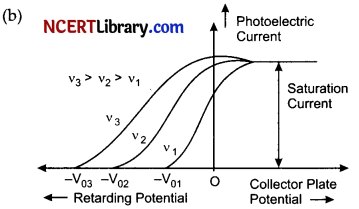
Variation of photoelectric current with collector plate potential for different frequencies of incident radiation
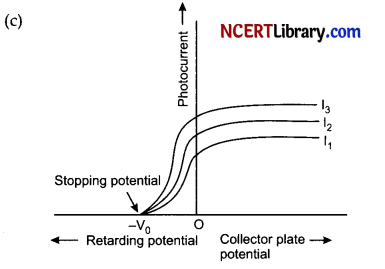
Variation of photocurrent with collector plate potential for different intensity of incident radiation.
Question 30.
The ground state energy of hydrogen atom is -13.6 eV. The photon emitted during the transition of electron from n = 3 to n = 1 state, is incident on a photosensitive material of unknown work function. The photoelectrons are emitted from the material with the maximum kinetic energy of 9 eV. Calculate the threshold wavelength of the material used. [3]
Answer:
A transition from n = 3 to n = 1 state, the energy of the emitted photon
hv = E2 – E1
= 13.6 \(\left[\frac{1}{1^2}-\frac{1}{3^2}\right]\)eV
= 12.1eV
From Einstein’s photoelectric equation,
hv = Kmax + W0
∴ W0 = hv – Kmax
= 12.1 – 9
= 3.1eV
Threshold wavelength,
λ0 = \(\frac{h c}{\mathrm{~W}_0}\)
= \(6.62 \times 10^{-34} \times 3 \times \frac{10^8}{3.1 \times 1.6 \times 19^{-19}}\)
= 4 x 10-7m
![]()
Section – D
Question 31.
(a) Draw equipotential surfaces for (i) an electric dipole and (ii) two identical positive charges placed near each other.
(b) In a parallel plate capacitor with air between the plates, each plate has an area of 6 x 10-3 m2 and the separation between the plates is 3 mm.
(i) Calculate the capacitance of the capacitor.
(ii) If the capacitor is connected to 100V supply, what would be the charge on each plate?
(iii) How would charge on the plate be affected if a 3 mm thick mica sheet of k = 6 is inserted between the plates while the voltage supply remains connected? [5]
OR
(a) Three charges – q, Q and – q are placed at equal distances on a straight line. If the potential energy of the system of these charges is zero, then what is the ratio Q : q?
(b) (i) Obtain the expression for the electric field intensity due to a uniformly charged spherical shell
of radius R at a point distant r from the centre of the shell outside it.
(ii) Draw a graph showing the variation of electric field intensity E with r, for r > R and r < R.
Answer:
(a) (i) a dipole
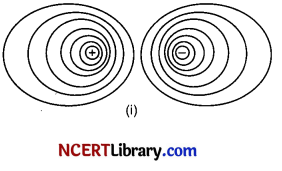
(ii) two identical positive charges.
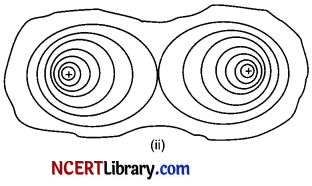
(b) In a parallel plate capacitor with air between the plates, each plate has an area of 6 x 10 3 m2 and the separation between the plates is 3 mm.
Here, A = 6 x 10-3 m2, d = 3mm = 3 x 10-3m
(i) Capacitance, C = \(\frac{\varepsilon_0 \mathrm{~A}}{d}=\left(\frac{8.85 \times 10^{-12} \times 6 \times 10^{-3}}{3 \times 19^{-3}}\right)\) = 17.7 x 10-12F
(ii) Charge, Q = CV =17.7 x 10-12 x 100 = 17.7 x 10-10 C
(iii) New charge Q = KQ = 6 x 17.7 x 10-10 = 1.062 x10-8 C
OR
(a) We know potential energy is a scalar quantity
Now total P.E = \(\frac{k(-q)(\mathrm{Q})}{x}+\frac{k(-q)(\mathrm{Q})}{x}+\frac{k(-q)(-q)}{2 x}\)
Given potential energy = 0
Latex
0 = \(\frac{-2 k q \mathrm{Q}}{x}+\frac{k q^2}{2 x}\)
Q : q = 1 : 4
(b) Consider a thin spherical shell of radius R with a positive charge q distributed uniformly on the surface. As the charge is uniformly distributed, the electric field is symmetrical and directed radially outward.
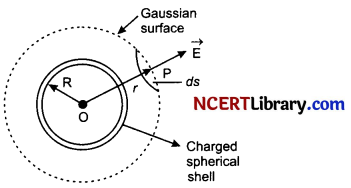
(i) When point P lies outside the spherical shell: Suppose that we have calculated the field at the point P at a distance r(r > R) from its centre. Draw Gaussian surface through point P so as to enclose the charged spherical shell. The Gaussian surface is a spherical surface of radius r and centre O.
Let E be the electric field at point P, then the electric flux through area element of area ds is
given by
dΦ = E.ds
Since ds is also normal to the surface.
∴ Total electric flux through the Gaussian surface is given by
Φ = ∫Eds = E ∫ds
Now, ∫ds = 4πr² … (i)
= E x 4πr²
Since the charge enclosed by the Gaussian surface is q, according to the Gauss’s theorem,
Φ = \(\frac{q}{\varepsilon_0}\) … (ii)
From equation (i) and (ii) we obtain
E x 4πr² = \(\frac{q}{\varepsilon_0}\)
E = \(\frac{q}{\left(4 \pi r^2 \varepsilon_0\right)}\)
(ii) The graph showing the variation of the electric field as a function of r is shown below
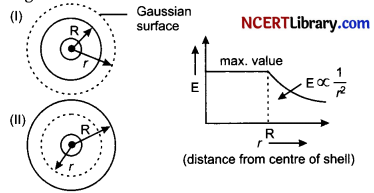
Question 32.
(a) Explain the term drift velocity of electrons in a conductor. Hence obtain the expression current through a conductor in terms of drift velocity.
(b) Two cells of emfs E1 and E2 and internal resistances r1 and r2 respectively are connected in parallel as shown in the figure. [5]
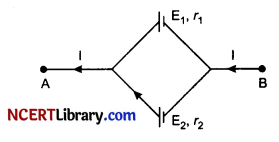
Deduce the expression for the:
(i) equivalent emf of the combination.
(ii) equivalent internal resistance of the combination.
(iii) potential difference between the points A and B.
OR
(a) State the two Kirchhoff’s rules used in the analysis of electric circuits and explain them.
(b) Derive the equation of the balanced state in a Wheatstone bridge using Kirchhoff’s laws.
Answer:
(a) Drift velocity: It is the average velocity acquired by the free electrons superimposed over the random motion in the direction opposite to electric field and along the length of the metallic conductor.
If e is the magnitude of charge on each electron, then the total charge in the conductor,
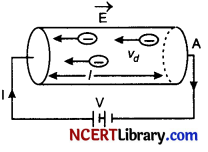
Q = (nAl)e … (i)
The time taken by the charge to cross the conductor length is given by
t = \(\frac{l}{v_d}\)
where vd is the drift velocity of electrons.
According to the definition of electric current,
I = \(\frac{\mathrm{Q}}{t}=\frac{n \mathrm{Al} l}{\frac{l}{v_d}}\)
I = neAvd
(b) Here, I = I1 + I2
Let V = Potential difference between A and B.
For cell ε1
Then, V = ε1 – I1 r1
⇒ I1 = \(\frac{\varepsilon_1-V}{r_1}\)
Similarly, for cell ε2, I2 = \(\frac{\varepsilon_2-\mathrm{V}}{r_2}\)
Putting these values in equation (i),

Comparing the above equation with the equivalent circuit of emf ‘eeq and internal resistance ‘reCj’ then,
Then V = εeq – Ireq …(iii)
(i) \(\varepsilon_{e q}=\frac{\varepsilon_1 r_2+\varepsilon_2 r_1}{r_1+r_2}\)
(ii) \(r_{e q}=\frac{r_1 r_2}{r_1+r_2}\)
(iii) The potential difference between A and B
V = εeq – Ireq
OR
(a) (i) Kirchhoff’s first law (junction rule): In an electrical circuit, the algebraic sum of currents meeting at a junction is always zero.
(ii) Kirchhoff’s second rule (loop rule) : In any closed mesh of an electrical circuit, the algebraic sum of the e.m.fs. is equal to the algebraic sum of products of resistances and current flowing through them.
(b) Wheatstone bridge (balanced) : Let i be the current from battery E. At point A, current i1 flows through resistance P and current i1 – i1 flows through R.
In balanced state, no current flows through BD, hence point B and D are at same potential.
Therefore, current i1 flows through resistance Q also and current i – i1 flows through S. Applying Kirchhoff’s loop rule in closed mesh ABDA,
i1P – (i – i1) R = 0 or i1P = (i – i1)R … (i)
In closed mesh BCDB,
i1Q – (i – i1) S = 0 or i1Q = (i – i1)S … (ii)
Dividing (i) from (ii), we get
\(\frac{P}{Q}=\frac{R}{S}\)
This is the condition for balance in a Wheatstone’s bridge
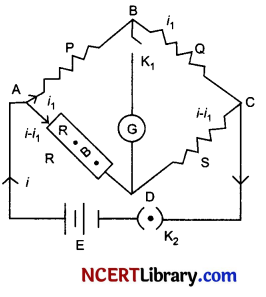
Question 33.
(a) Draw the graph showing intensity distribution of fringes with phase angle due to diffraction through a single slit. What is the width of the central maximum in comparison to that of a secondary maximum? [5]
(b) A ray PQ is incident normally on the face AB of a triangular prism of refracting angle 60° as shown in figure. The prism is made of a transparent material of refractive index \(\frac{2}{\sqrt{3}}\). Trace the path of the ray as it passes through the prism.
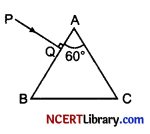
Calculate the angle of emergence and the angle of deviation.
OR
(a) Write two points of difference between an interference pattern and a diffraction pattern.
(b) (i) A ray of light incident on face AB of an equilateral glass prism, shows minimum deviation of 30°. Calculate the speed of light through the prism.
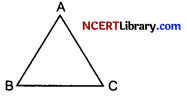
(ii) Find the angle of incidence at face AB so that the emergent ray grazes along the face AC.
Answer:
(a)
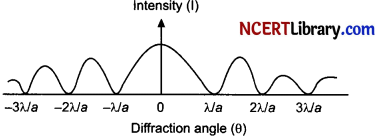
(b) Width of central maximum is twice that of any secondary maximum.
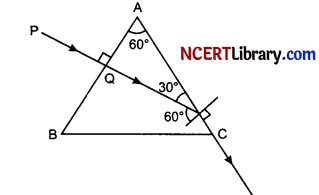
If ic is the critical angle for the prism/material,
μ = \(\frac{1}{\sin i_{\mathrm{C}}}\)
∴ \(\sin i_C=\frac{1}{\mu}=\frac{\sqrt{3}}{2}\)
⇒ iC = 60°
Angle of incidence at face AC of the prism = 60°
Hence, refracted ray grazes the surface AC.
⇒ Angle of emergence = 90°
⇒ Angle of deviation = 30°
OR
(a) (i) The interference pattern has a number of equally spaced bright and dark bands. The diffraction pattern has a central bright maximum which is twice as wide as the other maxima. The intensity falls as we go to successive maxima away from the centre, on either side.
(ii) We calculate the interference pattern by superposing two waves originating from the two narrow slits. The diffraction pattern is a superposition of a continuous family of waves originating from each point on a single slit.
(b)
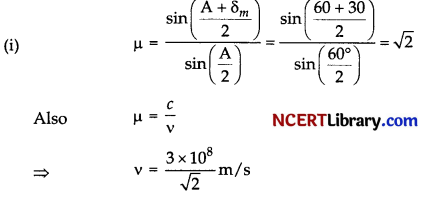
(ii) At face AC, let the angle of incidence be r2. For grazing ray.
e = 90°
⇒ μ = \(\frac{1}{\sin r_2}\)
⇒ r2 = sin-1 \(\left(\frac{1}{\sqrt{2}}\right)\) = 45°
Let angle of refraction at face AB be r1.
Now r1 + r2 = A
∴ r1 = A – r2 = 60° – 45° = 15°
Let angle of incidence at this face be i
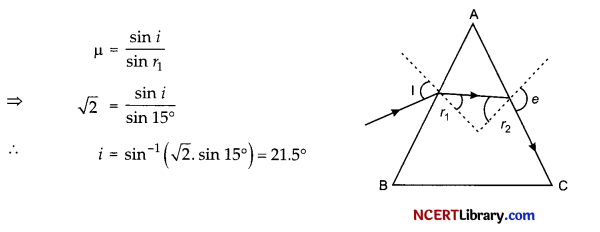
Section – E
Question 34.
Case Study:
Read the following paragraph and answer the questions.
A number of optical devices and instruments have been designed and developed such as periscope, binoculars, microscopes and telescopes utilising the reflecting and refracting properties of mirrors, lenses and prisms. Most of them are in common use. Our knowledge about the formation of images by the mirrors and lenses is the basic requirement for understanding the working of these devices. [4]
(i) Why the image formed at infinity is often considered most suitable for viewing. Explain.
(ii) In modem microscopes multi-component lenses are used for both the objective and the eyepiece. Why?
(iii) Write two points of difference between a compound microscope and an astronomical telescope.
OR
(iii) Write two distinct advantages of a reflecting type telescope over a refracting type telescope.
Answer:
(i) When the image is formed at infinity, we can see it with minimum strain in the ciliary muscles of the eye.
(ii) The multi-component lenses are used for both objective and the eye-piece to improve image quality by minimizing various optical aberrations in lenses.
(iii) (a) The compound microscope is used to observe minute nearby objects whereas the telescope is used to observe distant objects.
(b) In a compound microscope the focal length of the objective is lesser than that of the eye-piece whereas in a telescope the focal length of the objective is larger than that of the eyepiece.
OR
(iii) (a) The image formed by a reflecting type telescope is brighter than that formed by a refracting telescope.
(b) The image formed by the reflecting type telescope is more magnified than that formed by the refracting type telescope.
![]()
Question 35.
Case Study: Light emitting diode.
Read the following paragraph and answer the questions.
LED is a heavily doped p-n junction which under forward bias emits spontaneous radiation. When it is forward biased, due to recombination of holes and electrons at the junction, energy is released in the form of photons. In the case of Si and Ge diode, the energy released in recombination lies in the infrared region.
LEDs that can emit red, yellow, orange, green and blue light are commercially available. The semiconductor used for fabrication of visible LEDs must at least have a band gap of 1.8 eV. The compound semiconductor Gallium Arsenide – Phosphide is used for making LEDs of different colours. [4]
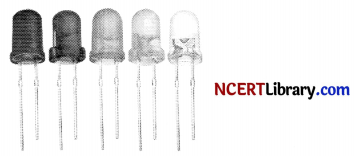
LEDs of different kinds
(i) Why are LEDs made of compound semiconductor and not of elemental semiconductors?
(ii) What should be the order of bandgap of an LED, if it is required to emit light in the visible range?
(iii) A student connects the blue coloured LED as shown in the figure. The LED did not glow when switch S is closed. Explain why?
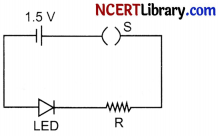
(iii) Draw VTI characteristic of a p-n junction diode in:
(i) forward bias and (ii) reverse bias
Answer:
(i) LEDs are made up of compound semiconductors and not by the elemental conductor because the band gap in the elemental conductor has a value that can detect the light of a wavelength which lies in the infrared (IR) region.
(ii) 1.8 eV to 3 eV
(iii) LED is reversed biased that is why it is not glowing.
OR
(iii) V-I Characteristic curves of p-n junction diode in forward biasing and reverse biasing.
